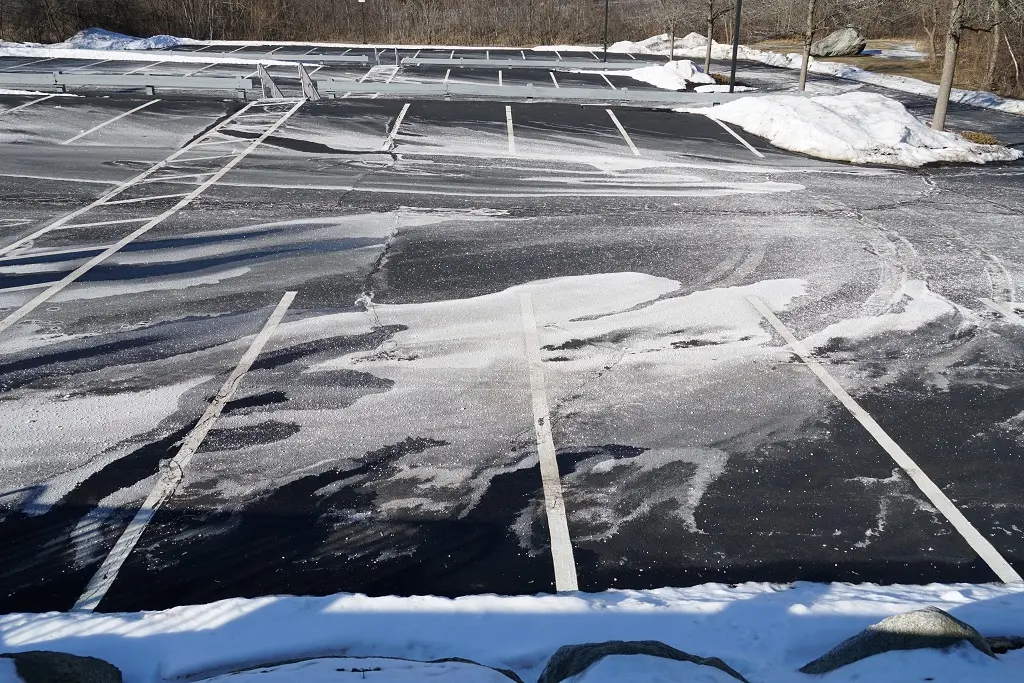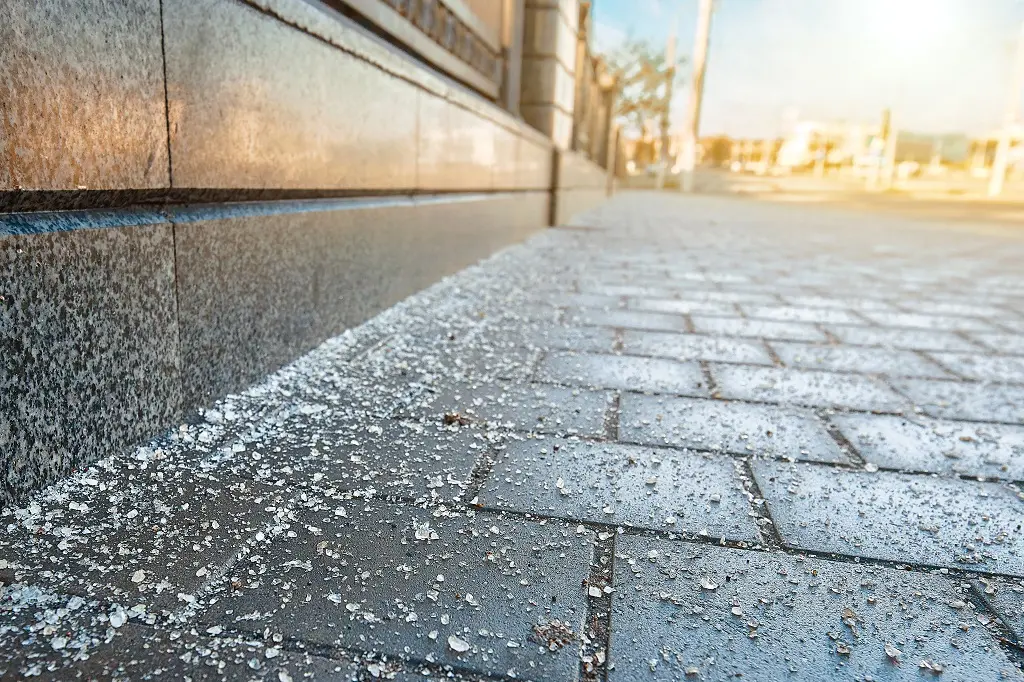When running a business, there are so many different elements to manage, and navigating the elements is one of them. With winter approaching, it’s important to consider the liability involved with the winter season, such as ice-covered parking lots. For this reason, it’s important for all business and property owners to properly follow salt application for parking lots protocol.
Even if you’re new to snow removal and parking lot salting, you probably know that it’s not just about throwing down rock salt or snow melt and calling it a day. Different temperatures, paving materials, and stages of the winter storm require different techniques and products for ice and snow removal. Using the wrong product could result in ineffective treatment or worsening conditions. Here are some of the most common mistakes we see when people salt their parking lots, driveway, or sidewalks.
Is It a Good Idea to Use Salt on Parking Lots?
If you’re questioning the benefits of putting salt on parking lots, rest assured – this process Is well worth the effort.
One of the greatest benefits of using road salt on your pavement is an immediate increase in safety. Based on a study by the American Highway Users Alliance, utilizing salt to de-ice roadways can reduce accidents by 93 percent. Plus, using salt to minimize ice can decrease accidents, too. And with salt being so affordable to purchase, it’s a low-budget security precaution you can take for your property.
How to Salt a Parking Lot: Best Practices

Not sure how to salt pavement? We’ve got you covered. To ensure the safety of everyone that visits your business, no matter the weather conditions, here are the best practices when salting parking lots.
1. The First Year of Parking Lot Maintenance: No Chemicals
First up, it’s important to keep your pavement clear of all snow and ice the first year after construction is completed.
During this first year, we recommend that no deicer of any kind be utilized before the concrete has had time to dry out thoroughly. Instead, we recommend using sand to provide slip resistance and traction during the first year. New concrete, even when properly implemented, will still show surface scaling if a chemical is used too soon after construction.
2. After the First Year of Maintenance: Use Rock Salt and Common Deicers
After your concrete has been in place for a year, you may begin using light to moderate applications of deicing chemicals. Typically, we recommend using rock salt, like sodium chloride-NaCI, instead of other deicing salts like calcium chloride or magnesium chloride.
Sodium chloride is effective at temperatures of 18 degrees Fahrenheit. And while the other salts mentioned above can operate at lower temperatures, they can be more aggressive to newer concrete.
3. Pre-Treat Your Parking Lot Before a Storm
Pre-treating pavement before a major storm is of great benefit in the long run, saving you both time and money. With this process, you can reduce your salt use to 25% compared to what you use if you de-ice after a storm.
There are a number of benefits to pre-treating, or anti-icing, your pavement before the winter weather hits. However, there are a few best practices to keep in mind to ensure you get the most out of this process.
In order to properly pre-treat your property, here are a few of the best practices:
- Use only as much anti-icer as truly needed. This will help ensure you get the most cost-effective benefits and minimize salt damage on the pavement.
- Use an anti-icer that is less harmful to plants compared to salt when applying near landscaping.
- Depending on conditions, it’s best to pre-treat a parking lot a few days ahead of a storm to combat frost and freezing drizzle. If this isn’t possible, wait until just before a storm hits.
- Wait until the placement temperature is 35 degrees Fahrenheit or less before applying calcium or magnesium chloride-based liquids. When applied to warmer pavement, these formulas will be slippery.
- If the temperatures in your parking lot fall below 15 degrees Fahrenheit, use anti-ice with granules or liquids instead of salts. Salts are not as effective at melting ice in these colder temperatures.
- Only use anti-ice if the forecast suggests it’s needed. Otherwise, this is not your most cost-effective solution.
- For convenience, you can spray pretreatment liquids on parking lot traffic lanes, allowing car tires to spread the treatment to parking spaces.
- Be sure to apply pretreatment liquids to the tops of hills and let the traffic pull the treatment down. This will prevent the accumulation of anti-icer at the bottom of a hill, which can make things slippery.
4. Use the Right Amount of Salt

As a rule of thumb, we recommend using about 2.3 pounds per 1,000 square feet when the pavement temperature is 30 degrees. This quantity is ideal when it comes to light snow or ice. However, that is just a baseline.
As temperatures drop, you need to increase how much salt you use for proper ice removal. In fact, moving from just 31 degrees to 16 degrees can triple how much salt is required.
Keep in mind, if you salt without plowing for snow removal, you will need more salt than in the case where you did plow.
Common Mistakes with Parking Lot Salting
There are a few common mistakes we see when it comes to salting parking lots. Here are a few of the top mistakes to avoid.
Only Using Rock Salt on Your Parking Lot
Sure, rock salt is the tried and true staple of snow removal and it’s an invaluable asset to parking lot de-icing. But rock salt alone will leave you with an incomplete strategy and will eventually impact your business.
A strategic combination of rock salt and snow melt is the best formula for success in the snow removal business. Rock salt is a great resource for after the storm — it makes quick work of snow and thin ice. Not to mention, it gives purchase to an otherwise slick surface. But what about before the storm even arrives? Take a proactive approach that will work even before the first flurry falls by spreading snow melt (magnesium chloride). What you’ll want for those situations is ice melt or snow melt — they’re slightly different formulations of salt that act as anti-icing agents. Just picture that parking lot snow melt away before it even has a chance to adhere — that’s what snow melt will do for you.
Taking this two-pronged approach is also important when you are expecting a heavy snowstorm.
Using Rock Salt & Ice Melt Incorrectly
Using rock salt and ice melt incorrectly can be costly to your business and can make you appear ineffective to clients.
With rock salt, make sure you use the product sparingly and only in temperatures above freezing. Ideally, you’ll be using rock salt on paths and parking lots after a storm blows through. Rock salt works best when it is applied over snow and ice. Not only is this more cost-efficient, but rock salt is highly corrosive. Over-deploying rock salt after a snow event can cause damage to your parking lot, corrosion to cars, or environmental damage.
On the other hand, ice melt should be pre-applied to the ground before the formation of ice and snow. It’s meant to be an anti-icing agent, so simply throwing it over a pile of snow like you would with rock salt won’t get you anywhere. And as with rock salt, use it sparingly — less is more in both cases.
Overusing Your Products

Nothing is more detrimental to our water sources than, when the Spring falls arrives, a steady stream of salt-infused water enters our rivers and waterways. Salt may be a product of nature, but it has a place in the global Ecosystem. That place isn’t in our drinking water and drainage systems.
Make sure you understand the products you’re working with: when are they effective, how should they be applied, what are the potential warnings, etc.
Not Plowing or Shoveling First
It’s easy to become spoiled by the almost magical qualities of rock salt and ice melt when they do their job. And while they’re both extremely effective tools in your snow removal arsenal, applying salt is just one step in the snow removal process.
The fact is, you still need to do the hard work of plowing and shoveling snow first. If you don’t, you’ll be spending your whole budget on bulk salt, contaminating the environment, and not doing a thorough job. This is especially true when there is a higher accumulation. Once the snow has compacted into ice, it is much more difficult (and dangerous) to manage.
Salt & Sand Don’t Work Together
It seems logical — mix sand in with your rock salt to maintain a more coarse texture that’ll help melt snow while giving people more purchase when they walk over the surface. On the contrary — all you’re doing is diluting your product and lessening its effect on snow or ice. Sand is merely meant as an emergency solution for quick traction in icy conditions.
Why Not Leave the Parking Lot Salting to Professionals?
Snow might not seem like a danger; after all, it is soft and fluffy. Left unchecked, snow can pose a serious threat to employees and customers. Not dealing with it effectively can make the situation more dangerous.
Salting your pavement can raise many questions. If you have any difficulty or if you’d like to find out more about how we can help you, don’t hesitate to reach out and get a quote from our snow removal experts. We’ll let you know exactly what we can do, and we’re happy to work around your company’s specific requirements.
